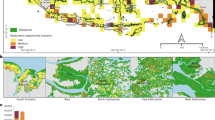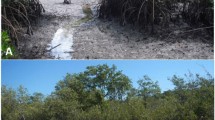Abstract
From half a million hectares at the turn of the century, Philippine mangroves have declined to only 120,000 ha while fish/shrimp culture ponds have increased to 232,000 ha. Mangrove replanting programs have thus been popular, from community initiatives (1930s–1950s) to government-sponsored projects (1970s) to large-scale international development assistance programs (1980s to present). Planting costs escalated from less than US$100 to over $500/ha, with half of the latter amount allocated to administration, supervision and project management. Despite heavy funds for massive rehabilitation of mangrove forests over the last two decades, the long-term survival rates of mangroves are generally low at 10–20%. Poor survival can be mainly traced to two factors: inappropriate species and site selection. The favored but unsuitable Rhizophora are planted in sandy substrates of exposed coastlines instead of the natural colonizers Avicennia and Sonneratia. More significantly, planting sites are generally in the lower intertidal to subtidal zones where mangroves do not thrive rather than the optimal middle to upper intertidal levels, for a simple reason. Such ideal sites have long been converted to brackishwater fishponds whereas the former are open access areas with no ownership problems. The issue of pond ownership may be complex and difficult, but such should not outweigh ecological requirements: mangroves should be planted where fishponds are, not on seagrass beds and tidal flats where they never existed. This paper reviews eight mangrove initiatives in the Philippines and evaluates the biophysical and institutional factors behind success or failure. The authors recommend specific protocols (among them pushing for a 4:1 mangrove to pond ratio recommended for a healthy ecosystem) and wider policy directions to make mangrove rehabilitation in the country more effective.




Similar content being viewed by others
References
ADB (1999) Program performance audit report on the fisheries sector program (Loans 971-PHI[SF]/972-PHI) in the Philippines. Available via Asian Development Bank. http://www.adb.org.ph
Agaloos BD (1994) Re-afforestation of mangrove forests in the Republic of the Philippines. In: Proceedings international tropical timber organization workshop: development and dissemination of re-afforestation techniques of mangrove forests. Japan Association for Mangroves, Japan, pp 75–98
Anon (2000) Northern Iloilo mangrove rehabilitation subproject (Region 6). Updated appraisal report. Department of Environment and Naural Resources. Prepared by Nippon Koei Co., Orient Integrated Consultants and Philkoei International. Unpublished report
Brown WH, Fischer AF (1920) Philippine mangrove swamps. In: Brown WH (ed) Minor products of Philippine forests I, Bureau of Forestry Bull. No. 22. Bureau of Printing, Manila, pp 9–125
Cabahug DM Jr, Ambi FM, Nisperos SO, Truzan NC Jr (1986) Impact of community-based mangrove forestation to mangrove dependent families and to nearby coastal areas in Central Visayas: a case example. In: National Mangrove Committee (ed) Mangroves of Asia and the Pacific: status and management. Natural Resources Management Center, Ministry of Natural Resources, Quezon City, Philippines, pp 441–466
Calumpong HP (1996) The Central Visayas regional project: lessons learned. Tambuli 1:12–17
Community Based Resource Management Project (2006a) Verdant hills, rejuvenated seas, and empowered communities. Success stories, best practices, and emerging models in community-based resource management. Unpublished report
Community Based Resource Management Project (2006b). Monitoring and evaluation report. Project Monitoring Office, Community-Based Resource Management Project and Department of Finance, Philippines. Unpublished report
Contreras A (ed) (2003) Creating space for local forest management in the Philippines. De La Salle University Press, Manila
Courtney CA, White AT (2000) Integrated coastal management in the Philippines: testing new paradigms. Coast Manage 28:39–53
De Leon ROD, White AT (1999) Mangrove rehabilitation in the Philippines. In: Streever W (ed) An international perspective on wetland rehabilitation. Kluwer, Netherlands, pp 37–42
Dizon-Pascua MA (ed) (2006) Faces of the sea, implementors’ perspective. Department of Agriculture, Bureau of Fisheries and Aquatic Resources, Fisheries Resource Management Program, Manila, Philippines
Erftemeijer PLA, Lewis RR (2000) Planting mangroves on intertidal mudflats: habitat restoration or habitat conversion? Proceedings of the Ecotone VIII—enhancing coastal ecosystems restoration for the 21st century. Royal Forest Department of Thailand, Bangkok, pp 156–165
Fisheries Resource Management Program (2003) Fisheries resource management program (FRMP) brief. Bureau of Fisheries and Aquatic Resources, Department of Agriculture, Quezon City, Philippines
Japan Bank for International Cooperation (2006) JBIC Project List. http://www.jbic.go.jp/english/oec/project/yen_loan_list.php. Cited 10 August 2006
Janiola ES Jr (1996) Mangrove rehabilitation and coastal resource management in Cogtong Bay: addressing mangrove management issues through community participation. In: Ferrer EM, dela Cruz LP, Domingo MA (eds) Seeds of hope. University of the Philippines and NGO Technical Working Group for Fisheries Reform and Advocacy, Quezon City, Philippines, pp 49–65
Melana DM, Atchue III JE, Yao CE, Edwards R, Melana EE, Gonzales HI (2000) Mangrove management handbook. Department of Environment and Natural Resources, Manila, Philippines through the Coastal Resource Management Project, Cebu City, Philippines
National Mangrove Committee (1987) Philippines Case Study. In: Mangroves of Asia and the Pacific: status and management. Tech Rep UNDP/UNESCO Research and Training Pilot Programme on Mangrove Ecosystems in Asia and the Pacific (RAS/79/002). Natural Resources Management Center and National Mangrove Committee, Ministry of Natural Resources, Philippines
National Forestation Development Office-DENR (2003) Forestry sector project (Loan No. Ph-P-135) completion report, vol 1. National Forestation Development Office, Department of Environment and Natural Resources
PCAFNRRD (1991) The Philippines recommends for mangrove production and harvesting. forestry research series no. 74. Philippine Council for Agriculture, Forestry and Natural Resources Research and Development, Department of Science and Technology, Los Banos, Laguna, p 96
Primavera JH (1995) Mangroves and brackishwater pond culture in the Philippines. Hydrobiologia 295:303–309
Primavera JH (2000) Development and conservation of Philippine mangroves: institutional issues. Ecol Econ 35:91–106
Primavera JH (2005) Mangroves, fishponds, and the quest for sustainability. Science 310(5745):57–59
Primavera JH, Agbayani RF (1997) Comparative strategies in community-based mangrove rehabilitation programmes in the Philippines. In: Hong PN, Ishwaran N, San HT, Tri NH, Tuan MS (eds) Proceedings of ecotone V, community participation in conservation, sustainable use and rehabilitation of mangroves in Southeast Asia. UNESCO, Japanese Man and the Biosphere National Committee and Mangrove Ecosystem Research Centre, Vietnam, pp 29–243
Primavera JH, Ashton EC (2005) Country case studies—Philippines. In: Principles for a code of conduct for the management and sustainable use of mangrove ecosystems. (Version 10 March 2005). World Bank/ISME/cenTER Aarhus, 106 pp. Work in Progress: http://mit.biology.au.dk/cenTER/MCB_Files/2005_MCB_Code_March.pdf. Cited 10 March 2005
Primavera JH, Sadaba RB, Lebata MJHL, Altamirano JP (2004) Handbook of mangroves in the Philippines—Panay. SEAFDEC Aquaculture Department, Iloilo, Philippines
REECS (2006) Community-based resource management project (CBRMP) impact evaluation (Loan Credit No. 4299 PH) vol 1, draft final report. Prepared by Resources, Environment and Economics Center for Studies (REECS), Quezon City, Philippines
Roldan RG (2004) An assessment of fish sanctuary and mangrove rehabilitation projects established under the fisheries resource management project. Technical monograph series 9. Bureau of Fisheries and Aquatic Resources, Department of Agriculture, Quezon City, Philippines
Saenger P, Hegerl EJ, Davie JDS (1983) Global status of mangrove ecosystems. IUCN Commission on Ecology Papers No. 3. Gland, Switzerland, p 88
Salmo III SG, Juinio-Menez MA (2001) Mangrove reforestation. Coastal research management trends. Marine resources foundation, inc. University of the Philippines Marine Research Institute, Quezon City
Samson MS, Rollon RN (2008) Growth performance of planted mangroves in the Philippines: revisiting forest management strategies. Ambio 37(4)
Sinohin VO, Garcia DC, Baconguis SR (1996) Manual on mangrove nursery establishment and development. Ecosystems Research and Development Bureau, Department of Environment and Natural Resources, College, Laguna, Philippines
Stevenson NJ, Lewis III RR, Burbridge PR (1999) Disused shrimp ponds and mangrove rehabilitation. In: Streever W (ed) An International Perspective on Wetland Rehabilitation. Kluwer, Netherlands, pp 277–297
Tomlinson PB (1986) The botany of mangroves. Cambridge University Press
Walters BB (2000) Local mangrove planting in the Philippines: are fisherfolk and fishpond owners effective restorationists? Resto Ecol 8(3):237–246
Walters BB (2003) People and mangroves in the Philippines: fifty years of coastal environmental change. Environ Conserv 30:293–303
Yao CE (1985) A walk in the Bakawan plantation of Banacon Island. Habitat 5(1):12–17
Yao CE (1986) Mangrove reforestation in Central Visayas. Canopy Int 12(2):6–9
Yao CE (1999a) Nong Denciong: Bakauan guardian of Banacon. Coastal Alert, DENR. www.oneocean.org. Cited 10 August 2006
Yao CE (1999b) Saving the Pangangan highway. Coastal Alert DENR. www.oneocean.org. Cited 10 August 2006
Yao CE, Nañagas F (1984) Banacon Island: Biggest bakauan plantation in Central Visayas. Canopy Int 10(5):3–5
Acknowledgements
We thank Raul Roldan, Team Leader of the FRMP-Project Management Consultants and Regional Adviser for Region 4A, for contributing FRMP data; Veneracion Garcia, Charles Castro and the staff of the Department of Finance-CBRMP Project Management Office, for helping the junior author gather CBRMP data; and to Ann Melano (formerly of the Coastal Marine Management Office) for information on DENR mangrove reforestation efforts. Our appreciation also goes to Stanley Tan of MIMA, Malaysia for the invitation to the International Conference and Exhibition on Mangroves of Indian and Western Pacific Oceans held in Kuala Lumpur August 21–24, 2006, where an early version of this paper was presented.
Author information
Authors and Affiliations
Corresponding author
Rights and permissions
About this article
Cite this article
Primavera, J.H., Esteban, J.M.A. A review of mangrove rehabilitation in the Philippines: successes, failures and future prospects. Wetlands Ecol Manage 16, 345–358 (2008). https://doi.org/10.1007/s11273-008-9101-y
Received:
Accepted:
Published:
Issue Date:
DOI: https://doi.org/10.1007/s11273-008-9101-y




